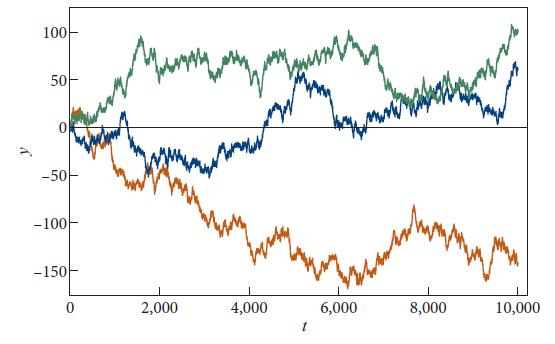A particle travels in 1 dimension, along the y axis, making a sequence of steps y
Question:
A particle travels in 1 dimension, along the y axis, making a sequence of steps △yj (labeled by the integer j ), each of which is △yj = +1 with probability 1/2, or △yj = −1with probability 1/2.
(a) After N >> 1 steps, the particle has reached location
![]()
What does the central limit theorem predict for the probability distribution of y(N)? What are its mean and its standard deviation?
(b) Viewed on length scales >> 1, y(N) looks like a continuous random process, so we shall rename N ≡ t . Using the (pseudo) random number generator from your favorite computer software language, compute a few concrete realizations of y(t) for 0 4 and plot them.4 Figure 6.1 above shows one realization of this random process.
(c) Explain why this random process is Markov.
(d) Use the central limit theorem to infer that the conditional probability P2 for this random process is

(e) Notice that this is the same probability distribution as we encountered in the diffusion exercise but with D = 1/2. Why did this have to be the case?
(f) Using an extension of the computer program you wrote in part (b), evaluate y(t = 104) for 1,000 realizations of this random process, each with y(0) = 0, then bin the results in bins of width δy = 10, and plot the number of realizations y(104) that wind up in each bin. Repeat for 10,000 realizations. Compare your plots with the probability distribution (6.17).
Figure 6.1

Step by Step Answer:

Modern Classical Physics Optics Fluids Plasmas Elasticity Relativity And Statistical Physics
ISBN: 9780691159027
1st Edition
Authors: Kip S. Thorne, Roger D. Blandford




